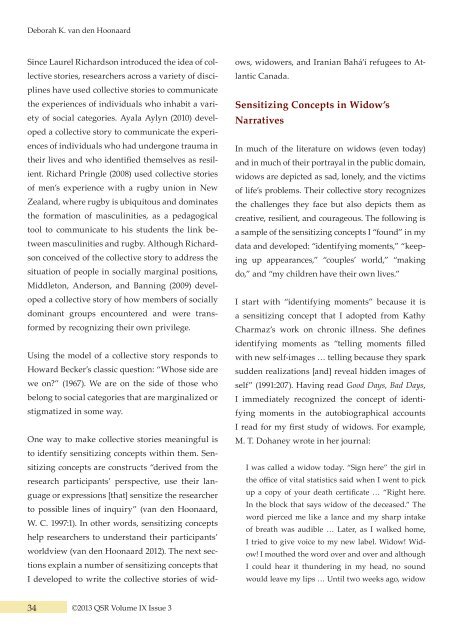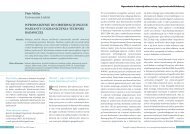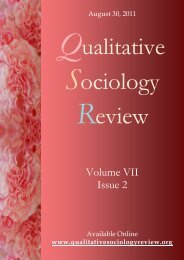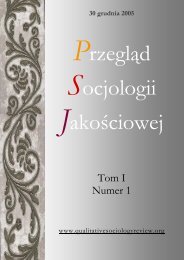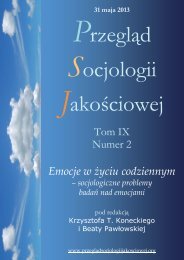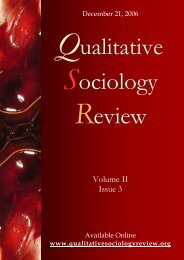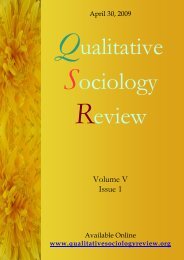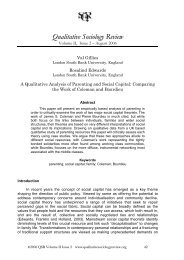Download this issue - Qualitative Sociology Review
Download this issue - Qualitative Sociology Review
Download this issue - Qualitative Sociology Review
You also want an ePaper? Increase the reach of your titles
YUMPU automatically turns print PDFs into web optimized ePapers that Google loves.
Deborah K. van den HoonaardTelling the Collective Story: Symbolic Interactionism in Narrative ResearchSince Laurel Richardson introduced the idea of collectivestories, researchers across a variety of disci-ows, widowers, and Iranian Bahá’í refugees to AtlanticCanada.was only a word in the English language. Now it wasme… (1989:6-7 as cited in van den Hoonaard 1997)friends, they have to “be fairly cheerful and upbeat”and not talk about their husbands too much:plines have used collective stories to communicatethe experiences of individuals who inhabit a varietyof social categories. Ayala Aylyn (2010) developeda collective story to communicate the experiencesof individuals who had undergone trauma intheir lives and who identified themselves as resilient.Richard Pringle (2008) used collective storiesof men’s experience with a rugby union in NewZealand, where rugby is ubiquitous and dominatesthe formation of masculinities, as a pedagogicaltool to communicate to his students the link betweenmasculinities and rugby. Although Richardsonconceived of the collective story to address thesituation of people in socially marginal positions,Middleton, Anderson, and Banning (2009) developeda collective story of how members of sociallydominant groups encountered and were transformedby recognizing their own privilege.Using the model of a collective story responds toHoward Becker’s classic question: “Whose side arewe on?” (1967). We are on the side of those whobelong to social categories that are marginalized orstigmatized in some way.One way to make collective stories meaningful isto identify sensitizing concepts within them. Sensitizingconcepts are constructs “derived from theresearch participants’ perspective, use their languageor expressions [that] sensitize the researcherto possible lines of inquiry” (van den Hoonaard,W. C. 1997:1). In other words, sensitizing conceptshelp researchers to understand their participants’worldview (van den Hoonaard 2012). The next sectionsexplain a number of sensitizing concepts thatI developed to write the collective stories of wid-Sensitizing Concepts in Widow’sNarrativesIn much of the literature on widows (even today)and in much of their portrayal in the public domain,widows are depicted as sad, lonely, and the victimsof life’s problems. Their collective story recognizesthe challenges they face but also depicts them ascreative, resilient, and courageous. The following isa sample of the sensitizing concepts I “found” in mydata and developed: “identifying moments,” “keepingup appearances,” “couples’ world,” “makingdo,” and “my children have their own lives.”I start with “identifying moments” because it isa sensitizing concept that I adopted from KathyCharmaz’s work on chronic illness. She definesidentifying moments as “telling moments filledwith new self-images … telling because they sparksudden realizations [and] reveal hidden images ofself” (1991:207). Having read Good Days, Bad Days,I immediately recognized the concept of identifyingmoments in the autobiographical accountsI read for my first study of widows. For example,M. T. Dohaney wrote in her journal:I was called a widow today. “Sign here” the girl inthe office of vital statistics said when I went to pickup a copy of your death certificate … “Right here.In the block that says widow of the deceased.” Theword pierced me like a lance and my sharp intakeof breath was audible … Later, as I walked home,I tried to give voice to my new label. Widow! Widow!I mouthed the word over and over and althoughI could hear it thundering in my head, no soundwould leave my lips … Until two weeks ago, widowIn interviews with widows, the intensity of the identifyingmoment is a central part of the narrative:All of a sudden it occurred to me, “I am a widow.” Eventhough my mail may come to me as Mrs. ________,I am a widow… And it was like all of a sudden I realizedit… It hadn’t occurred to me…at the time ofdeath or at the funeral… Just all of a sudden, it hit me,“Hey, I am a widow.” (van den Hoonaard 2001:37) 1It hit me so hard, it almost turned me sick for the moment.Somebody said, “You’re a widow.” And, it almostmade me feel sick to my stomach. That was the firsttime – I had never thought of myself as a widow. (p. 38)These stories of the discovery of a new identity,the identifying moment, carry a power in the tellingthat far exceeds a third-person description.Through the shock and sudden recognition describedalmost like being punched in the stomach,the story demonstrates that being a widow is anunwelcome identity that carries with it stigma andlower status. In fact, most widows say that they dislikethe term. Even one of the reviewers of my articleentitled “Identity Foreclosure,” herself a widow,commented on her discomfort with the term.As all research has shown, when a woman becomesa widow, she loses many of her friends. The womenI interviewed concurred. They also knew that theyhad lower status as single women and particularresponsibilities, one of which was “keeping up appearances.”This sensitizing concept refers to widows’understanding that if they want to keep their1All quotations in <strong>this</strong> section, unless otherwise noted, arefrom van den Hoonaard (2001).Well, you’re going to go away from here thinking thatI’m fine and I feel fine. Maybe you won’t be at the endof the road ‘til I’ll be weeping, but that’s all right. (p. 65)If I’d have wept and wailed and howled [in myfriend’s] soup for the last six months…[my husband]would be very upset with me… Very disapproving…ashamed of me. (p. 64)Part of “keeping up appearances” is conforming tofeeling rules by doing the emotion work (Hochschild1979) necessary to succeed:I just decided I have to pull myself together, youknow, take the bull by the horns. I have always triedto be very cheerful about the whole thing. (van denHoonaard 2001:65)The way widows talk about the importance ofkeeping up appearances communicates their lowerstatus. If they do not succeed, they will lose anyfriends who did not desert them at the start.A related sensitizing concept is “couples’ world”which refers to the widows’ feeling of not fittinginto society in a comfortable way. When friends invitethem out:And much as they say, “Well you’re welcome to comewith us,” you always feel like the third person out. (p. 73)I know that there’s always going to be parties…thatwe used to go to that I’m not going to be included…I tell you, it’s a couples’ world. (p. 74)Another aspect of widows’ collective story relatesto their relationship with money. For most, “making34©2013 QSR Volume IX Issue 3<strong>Qualitative</strong> <strong>Sociology</strong> <strong>Review</strong> • www.qualitativesociologyreview.org 35


